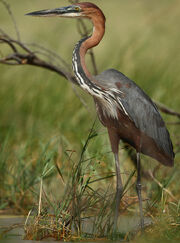| ||||||||||||||
The Bennu bird was a cryptid reported from Egypt, a giant heron which was used to represent the ancient Egyptian deity Bennu. It is sometimes thought to have been the giant or Bennu heron (Ardea bennuides), which is thought to have gone extinct around 1800 B.C..[1] However, there is some evidence that such an animal may have existed in Egypt up until the early 19th Century.[2][3]
Description[]
The Bennu bird was depicted in Ancient Egyptian art as an enormous heron taller than a man, with a pair of plumed feathers on its head, and occasionally a shorter plume on its chest.[2]
Furthermore, as described by pharaonic period Egyptian documents, the Nile Delta was once home to a giant bird, alleged to be a stork, which lived in large flocks. Individuals of both sexes had white plumage, long tail feathers, and a long and straight bill, while the males were distinguished also by a tuft of feathers on the back of the head, and another on the breast.[2][4]
Sightings[]
Undated[]
The giant "stork" still existed in the Nile Delta during the reign of the Pharaoh Khufu or Cheops (in the 26th Century B.C.), when it was sometimes trapped by local peasants.[2][4]
1820's[]
According to Egyptologist Joseph Bonomi, sometime between 1821 and 1823 the Egyptologist James Burton had come across "three enormous conical nests, all within the space of a mile," on Egypt's Red Sea coast, near a place named Gebel ez Zeit or Gebel Zeit. The nests were constructed out of sticks, weeds, fish bones, a shoe, woollen cloth, a watch, and a human ribcage, had a height of around 15', and a diameter of 2.5' to 3'. When Burton questioned locals about the nests, he was told that they were made by enormous stork-like birds which used to live in the area, but had disappeared shortly before Burton's arrival.[2][4]
Theories[]

The giant goliath heron (Ardea goliath) of Africa, photograped by Steve Garvie, was formerly considered the likeliest inspiration for the Bennu bird.
Archaeologist Ella Hoch of Copenhagen University is noted for her investigations into the origin of the Bennu bird. Initially, she theorised that it was based on the grey heron (Ardea cinerea), but exaggerated to reflect Bennu's significance. Alternatively, she suggested that it might have been inspired by stories of the foreign goliath heron (Ardea goliath), which stands up to 5' tall and is found in sub-Saharan Africa and the tip of the Arabian Peninsula.[2] A third putative explanation was the purple heron (Ardea purpurea), which has a long black crest and is found throughout Africa and the Middle East.[1]
During the 1970's, however, Hoch discovered the remains of an enormous heron in material unearthed on the island of Umm an-Nar, in the United Arab Emirates. Based on the lower leg bone initially discovered, and on remains found later, it was estimated that this heron could have stood up to nearly 7' tall, with a wingspan of almost 9'. Furthermore, various remains were dated to 2,600 B.C. to 2,000 B.C., and around 1,800 B.C., the period in which the Bennu bird was being illustrated. Realising that this bird would have been the likeliest model for the Bennu bird, Hoch described it as Ardea bennuides in 1977.[2]
Karl Shuker also notes that the descriptions of the Nile Delta's giant "stork" are actually more reminiscent of a heron, and compare particularly well with depictions of the Bennu bird, leading him to query whether the alleged stork was in fact Ardea bennuides.[2]
Notes and references[]
- ↑ 1.0 1.1 Eberhart, George M. (2002) Mysterious Creatures: A Guide to Cryptozoology, ABC-CLIO, Inc., ISBN 1576072835
- ↑ 2.0 2.1 2.2 2.3 2.4 2.5 2.6 2.7 Shuker, Karl P. N. (2016) Still In Search Of Prehistoric Survivors: The Creatures That Time Forgot?, Coachwhip Publications, ISBN 978-1616463908
- ↑ Shuker, Karl P. N. ShukerNature: GIANT BIRDS FROM THE TOMBS OF THE PHARAOHS karlshuker.blogspot.com [Accessed 24 May 2020]
- ↑ 4.0 4.1 4.2 Bonomi, Joseph "On a Gigantic Bird Sculptured on the Tomb of an Officer of the Household of Pharaoh," American Journal of Science 49 (1845)

